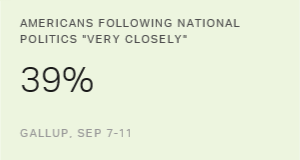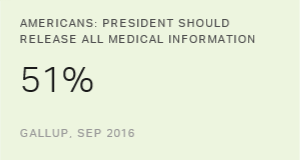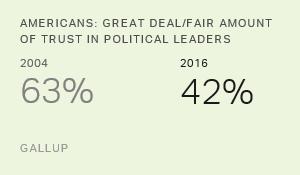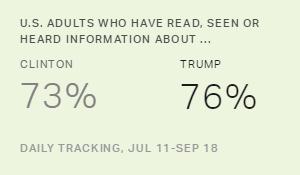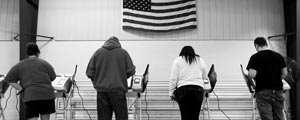Story Highlights
- 39% say they follow national politics "very closely," up from 31% in 2015
- Republicans more likely than Democrats to follow national politics very closely
- Younger Americans' attention to national politics has waned since 2008
WASHINGTON, D.C. -- In this presidential election year, nearly four in 10 Americans say they are following news about national politics "very closely." Americans' attention to national politics traditionally peaks in presidential election years compared with intervening years, and that is the case in 2016. The 39% who say they are following national politics very closely is up from 31% in 2015 and is similar to the percentages who paid close attention in 2012, 2008 and 2004.

As more Americans report following politics "very closely" this year compared with 2015, fewer report following it "somewhat closely" -- down seven percentage points to 39%. This suggests those who followed political news on a slightly more casual basis last year have intensified their interest this year. Meanwhile, since 2013, a fairly consistent 23% of adults, on average, have said they follow news about politics "not too closely" or "not at all."
The latest results come from Gallup's annual Governance survey, conducted Sept. 7-11. Because Gallup has asked Americans about their attention to national politics in September of each year since 2001, the measures are drawn from similar points in each presidential election cycle.
Republicans Pay Slightly More Attention to Politics Than Democrats Do
Since 2001, Republicans have been slightly more likely than Democrats to say they follow national politics very closely. During President Barack Obama's first term, however, the gap widened. Between 2009 and 2012, Republicans' attention to national politics outpaced Democrats' by an average of nine points, compared with a four-point gap in the years before his first term and six points afterward.
Democrats' and Republicans' close attention to national politics has peaked in presidential election years since at least 2004. However, independents' attention to national politics has not spiked in recent presidential years after doing so in 2004 and 2008.
In 2016, the percentage of Republicans and Democrats paying very close attention to national politics jumped nine and 14 points, respectively, from 2015. These increases are exceeded only by those seen from 2007 to 2008 among Republicans (18 points) and Democrats (15 points). Those spikes may have taken place because that presidential election was the first to feature a black major-party nominee and was one in which the winner would confront two major wars and a bad economy.
The 2016 presidential election does not appear to be drawing independents' attention, which is essentially unchanged from last year. This marks a change from the presidential election eight years ago, when the percentage of independents following national politics very closely increased by seven points from 2007 to 2008.
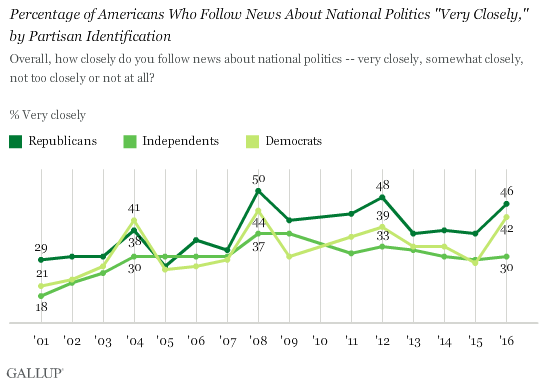
Older Americans More Attentive Than Younger Americans to National Politics
Older Americans consistently follow news about national politics more closely than middle-aged and younger Americans, but age groups' attention typically increases in presidential election years. Four in 10 middle-aged Americans in 2016 are paying very close attention to national politics, up from 27% last year, which represents the largest increase among all age groups. Younger Americans (20% "very closely") are paying the least attention to national politics this year, while older Americans, as is typically the case, are paying the most attention (49%).
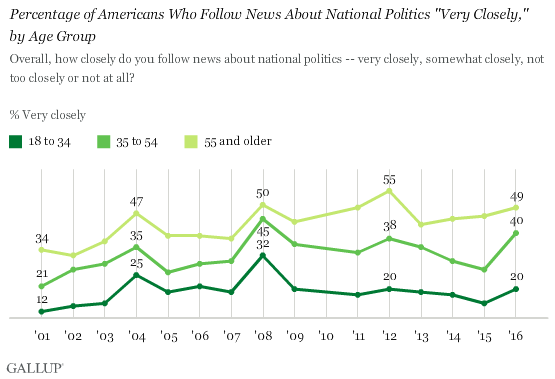
Middle-aged and younger Americans' attention peaked in 2008, when 45% and 32%, respectively, said they followed national politics "very closely." Among younger Americans, this could have reflected interest in Obama's presidential campaign which was, in part, driven by a coalition that prominently featured younger voters.
Since 2008, the share of attentive younger Americans has faded substantially, with only a fifth paying very close attention in 2012 and 2016 -- similar to non-presidential-election years. Older Americans' attention peaked in 2012, when 55% said they followed national politics "very closely."
Bottom Line
While political independents and younger adults generally pay less attention to national politics than Democrats, Republicans and older Americans do, these groups' attention has waned since the 2008 presidential election year. In 2016, this could reflect the presidential candidates' failure to resonate with young adults and independents, who represent critical voting blocs. Hillary Clinton and Donald Trump are posting historically bad image ratings for presidential candidates overall, and both candidates have been particularly unpopular with young adults and independents.
Gallup recently reported that 33% of 18- to 29-year-old adults had a favorable image of Clinton, while 18% had a favorable image of Trump -- the lowest favorability among all age groups for both candidates. Similarly, less than a third of independents hold favorable images of Clinton and Trump. To the extent that close attention to politics translates into voter turnout, this could be an indication of low turnout among younger Americans and independents on Election Day.
Historical data are available in Gallup Analytics.
Survey Methods
Results for this Gallup poll are based on telephone interviews conducted Sept. 7-11, 2016, with a random sample of 1,020 adults, aged 18 and older, living in all 50 U.S. states and the District of Columbia. For results based on the total sample of national adults, the margin of sampling error is ±4 percentage points at the 95% confidence level. All reported margins of sampling error include computed design effects for weighting.
Each sample of national adults includes a minimum quota of 60% cellphone respondents and 40% landline respondents, with additional minimum quotas by time zone within region. Landline and cellular telephone numbers are selected using random-digit-dial methods.
Learn more about how the Gallup Poll Social Series works.
